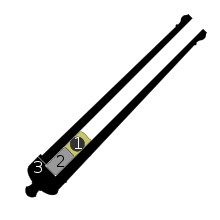Touch hole

1. the projectile or cannonball (shot)
2. gunpowder
3. touch hole (or vent)

A touch hole is a small hole through which the propellant charge of a cannon or muzzleloading gun is ignited. In small arms, the flash from a charge of priming held in the flash pan is enough to ignite the charge within.[1] In artillery, priming powder, a fuse, squib, or friction igniter is inserted into the touch hole to ensure ignition of the charge.
The powder in the touch hole was lit either with a slow match, a linstock or a type of flintlock mechanism that was known as a gunlock.
Spiking the guns
If a cannon was in danger of being captured by the enemy, its crew would "spike" the gun to prevent it from being used against them. This would involve hammering a barbed steel spike into the touch-hole, which could be removed only with great difficulty. Covert missions to spike the enemy's guns could also be done to prevent counterattacks and protect ships during withdrawal, as in the case of the Ranger's attack on Whitehaven during the American Revolutionary War.
Count Friedrich Wilhelm von Bismarck, in his Lectures on the Tactics of Cavalry, recommended that every cavalry soldier should carry the equipment needed to spike guns if an encounter with enemy artillery was expected.[2]
References
- ↑ Vauban and the French military under Louis XIV, Jean-Denis G. G. Lepage, p.38
- ↑ Bismarck, Friedrich Wilhelm (1855). On the Uses and Application of Cavalry in War. London: T and W Boone. p. viii. Retrieved September 13, 2012., translated by North Ludlow Beamish